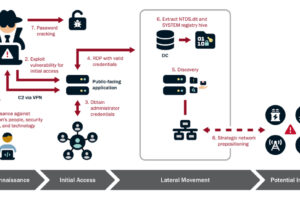PRC State-Sponsored Actors Compromise and Maintain Persistent Access to U.S. Critical Infrastructure

The Cybersecurity and Infrastructure Security Agency (CISA), National Security Agency (NSA), and Federal Bureau of Investigation (FBI) assess that People’s Republic of China (PRC) state sponsored cyber actors are seeking to pre position themselves on IT networks for disruptive or destructive cyberattacks against U.S. critical infrastructure in the event of a major crisis or conflict with the United States.
Actions to take today to mitigate Volt Typhoon activity:
• Apply patches for internet-facing systems. Prioritize patching critical vulnerabilities in appliances known to be frequently exploited by Volt Typhoon.
• Implement phishing-resistant MFA.
• Ensure logging is turned on for application, access, and security logs and store logs in a central system.
CISA, NSA, FBI and partners released this advisory to warn critical infrastructure organizations about this assessment, which is based on observations from the U.S. authoring agencies’ incident response activities at critical infrastructure organizations compromised by the PRC state-sponsored cyber group known as Volt Typhoon (also known as Vanguard Panda, BRONZE SILHOUETTE, Dev-0391, UNC3236, Voltzite, and Insidious Taurus)
The U.S. authoring agencies have confirmed that Volt Typhoon has compromised the IT environments of multiple critical infrastructure organizations—primarily in Communications, Energy, Transportation Systems, and Water and Wastewater Systems Sectors—in the continental and non continental United States and its territories, including Guam. Volt Typhoon’s choice of targets and pattern of behavior is not consistent with traditional cyber espionage or intelligence gathering operations, and the U.S. authoring agencies assess with high confidence that Volt Typhoon actors are pre-positioning themselves on IT networks to enable lateral movement to OT assets to disrupt functions. The U.S. authoring agencies are concerned about the potential for these actors to use their network access for disruptive effects in the event of potential geopolitical tensions and/or military conflicts. CCCS assesses that the direct threat to Canada’s critical infrastructure from PRC state sponsored actors is likely lower than that to U.S. infrastructure, but should U.S. infrastructure be disrupted, Canada would likely be affected as well, due to cross-border integration. ASD’s ACSC and NCSC-NZ assess Australian and New Zealand critical infrastructure, respectively, could be vulnerable to similar activity from PRC state-sponsored actors.
As the authoring agencies have previously highlighted, the use of living off the land (LOTL) techniques is a hallmark of Volt Typhoon actors’ malicious cyber activity when targeting critical infrastructure. The group also relies on valid accounts and leverage strong operational security, which combined, allows for long-term undiscovered persistence. In fact, the U.S. authoring agencies have recently observed indications of Volt Typhoon actors maintaining access and footholds within some victim IT environments for at least five years. Volt Typhoon actors conduct extensive pre-exploitation reconnaissance to learn about the target organization and its environment; tailor their tactics, techniques, and procedures (TTPs) to the victim’s environment; and dedicate ongoing resources to maintaining persistence and understanding the target environment over time, even after initial compromise.
The authoring agencies urge critical infrastructure organizations to apply the mitigations in this advisory and to hunt for similar malicious activity using the guidance herein provided, along with the recommendations found in joint guide Identifying and Mitigating Living Off the Land Techniques.
These mitigations are primarily intended for IT and OT administrators in critical infrastructure organizations. Following the mitigations for prevention of or in response to an incident will help disrupt Volt Typhoon’s accesses and reduce the threat to critical infrastructure entities.
If activity is identified, the authoring agencies strongly recommend that critical infrastructure organizations apply the incident response recommendations in this advisory and report the incident to the relevant agency.

